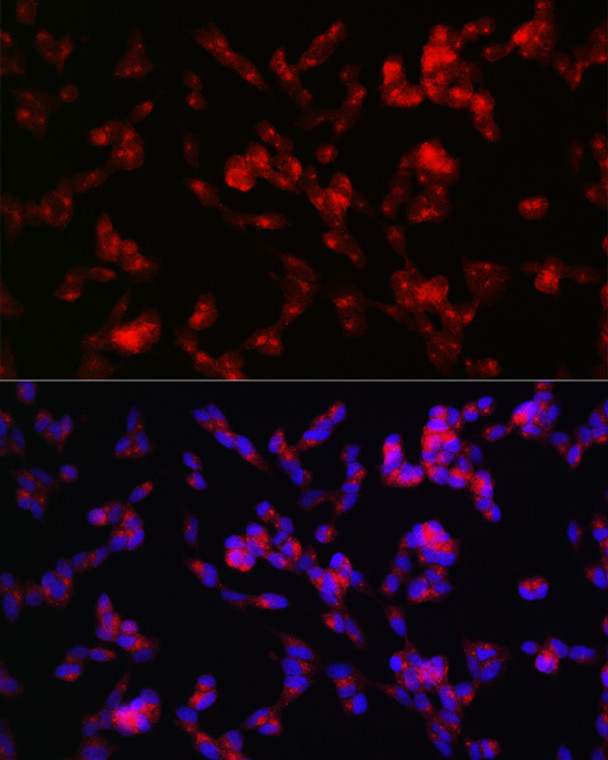| Host: |
Rabbit |
| Applications: |
WB/IF |
| Reactivity: |
Human/Mouse/Rat |
| Note: |
STRICTLY FOR FURTHER SCIENTIFIC RESEARCH USE ONLY (RUO). MUST NOT TO BE USED IN DIAGNOSTIC OR THERAPEUTIC APPLICATIONS. |
| Short Description: |
Rabbit polyclonal antibody anti-ADAMTS4 (74-318) is suitable for use in Western Blot and Immunofluorescence research applications. |
| Clonality: |
Polyclonal |
| Conjugation: |
Unconjugated |
| Isotype: |
IgG |
| Formulation: |
PBS with 0.05% Proclin300, 50% Glycerol, pH7.3. |
| Purification: |
Affinity purification |
| Dilution Range: |
WB 1:500-1:2000IF/ICC 1:50-1:200 |
| Storage Instruction: |
Store at-20°C for up to 1 year from the date of receipt, and avoid repeat freeze-thaw cycles. |
| Gene Symbol: |
ADAMTS4 |
| Gene ID: |
9507 |
| Uniprot ID: |
ATS4_HUMAN |
| Immunogen Region: |
74-318 |
| Immunogen: |
Recombinant fusion protein containing a sequence corresponding to amino acids 74-318 of human ADAMTS4 (NP_005090.3). |
| Immunogen Sequence: |
GSGAPARLLCRLQAFGETLL LELEQDSGVQVEGLTVQYLG QAPELLGGAEPGTYLTGTIN GDPESVASLHWDGGALLGVL QYRGAELHLQPLEGGTPNSA GGPGAHILRRKSPASGQGPM CNVKAPLGSPSPRPRRAKRF ASLSRFVETLVVADDKMAAF HGAGLKRYLLTVMAAAAKAF KHPSIRNPVSLVVTRLVILG SGEEGPQVGPSAAQTLRSFC AWQRGLNTPEDSDPDHFDT |
| Tissue Specificity | Expressed in brain, lung and heart. Expressed at very low level in placenta and skeletal muscles. Isoform 2: Detected in osteoarthritic synovium. |
| Post Translational Modifications | The precursor is cleaved by a furin endopeptidase. Glycosylated. Can be O-fucosylated by POFUT2 on a serine or a threonine residue found within the consensus sequence C1-X(2)-(S/T)-C2-G of the TSP type-1 repeat domains where C1 and C2 are the first and second cysteine residue of the repeat, respectively. Fucosylated repeats can then be further glycosylated by the addition of a beta-1,3-glucose residue by the glucosyltransferase, B3GALTL. Fucosylation mediates the efficient secretion of ADAMTS family members. Can also be C-glycosylated with one or two mannose molecules on tryptophan residues within the consensus sequence W-X-X-W of the TPRs, and N-glycosylated. These other glycosylations can also facilitate secretion. |
| Function | Cleaves aggrecan, a cartilage proteoglycan, and may be involved in its turnover. May play an important role in the destruction of aggrecan in arthritic diseases. Could also be a critical factor in the exacerbation of neurodegeneration in Alzheimer disease. Cleaves aggrecan at the '392-Glu-|-Ala-393' site. |
| Protein Name | A Disintegrin And Metalloproteinase With Thrombospondin Motifs 4Adam-Ts 4Adam-Ts4Adamts-4Admp-1Aggrecanase-1 |
| Database Links | Reactome: R-HSA-1474228Reactome: R-HSA-5083635Reactome: R-HSA-5173214 |
| Cellular Localisation | SecretedExtracellular SpaceExtracellular Matrix |
| Alternative Antibody Names | Anti-A Disintegrin And Metalloproteinase With Thrombospondin Motifs 4 antibodyAnti-Adam-Ts 4 antibodyAnti-Adam-Ts4 antibodyAnti-Adamts-4 antibodyAnti-Admp-1 antibodyAnti-Aggrecanase-1 antibodyAnti-ADAMTS4 antibodyAnti-KIAA0688 antibodyAnti-UNQ769 antibodyAnti-PRO1563 antibody |
Information sourced from Uniprot.org
12 months for antibodies. 6 months for ELISA Kits. Please see website T&Cs for further guidance







